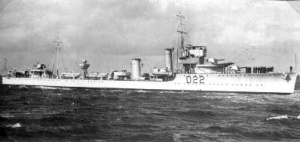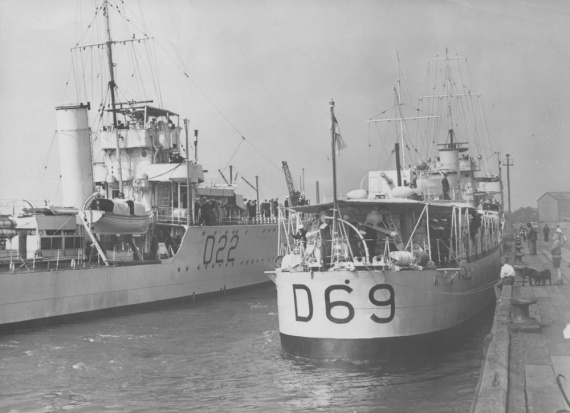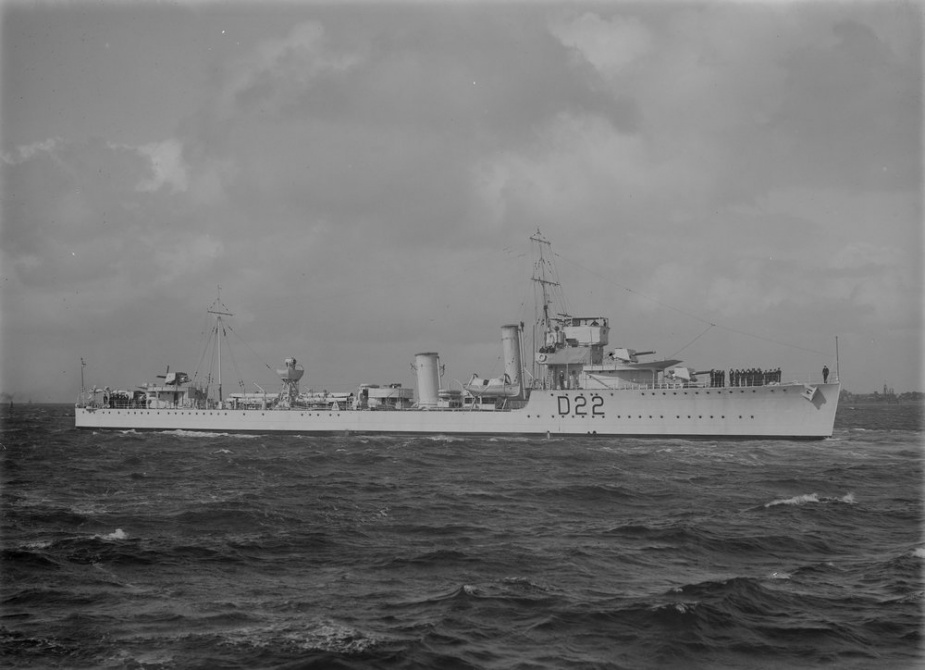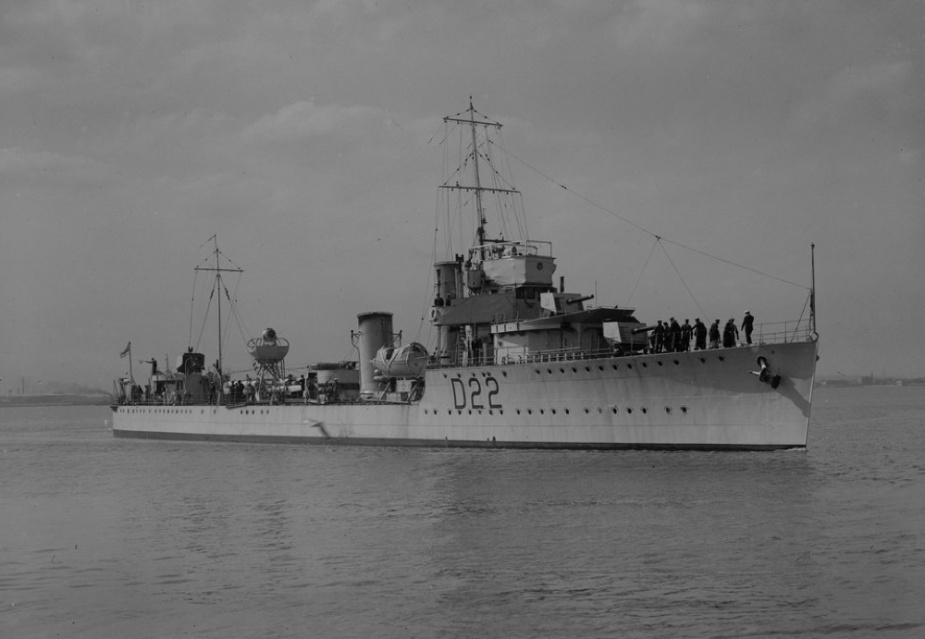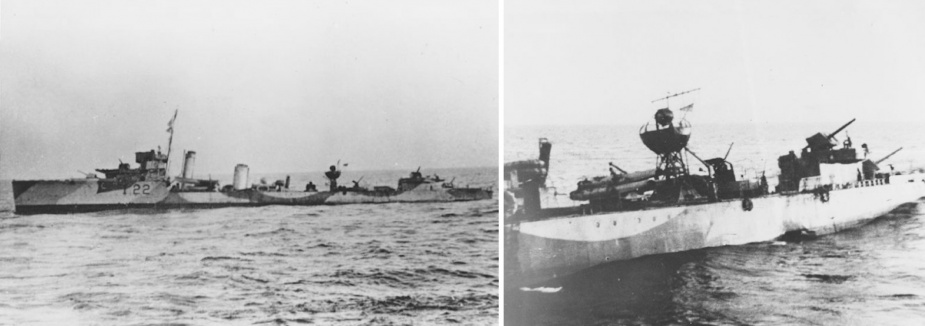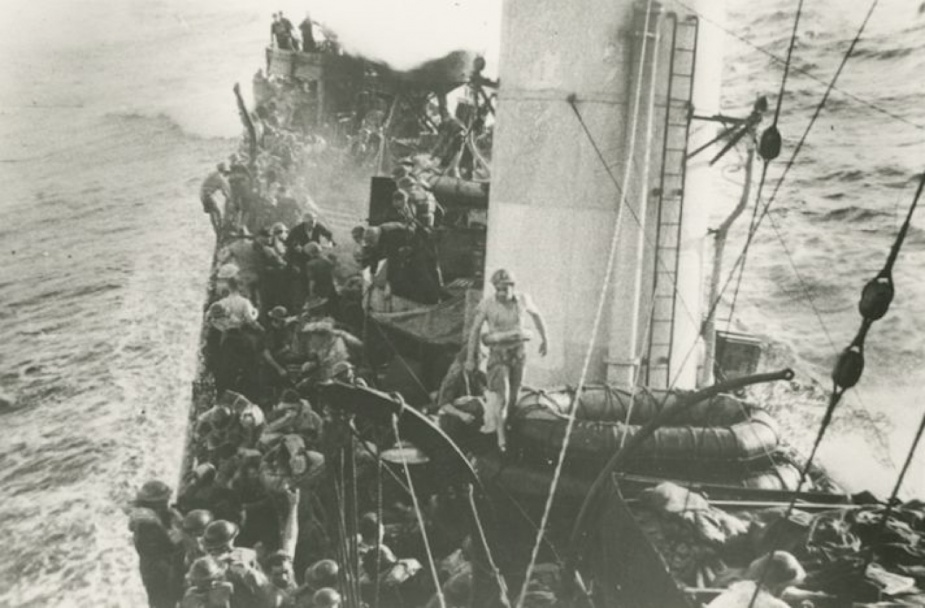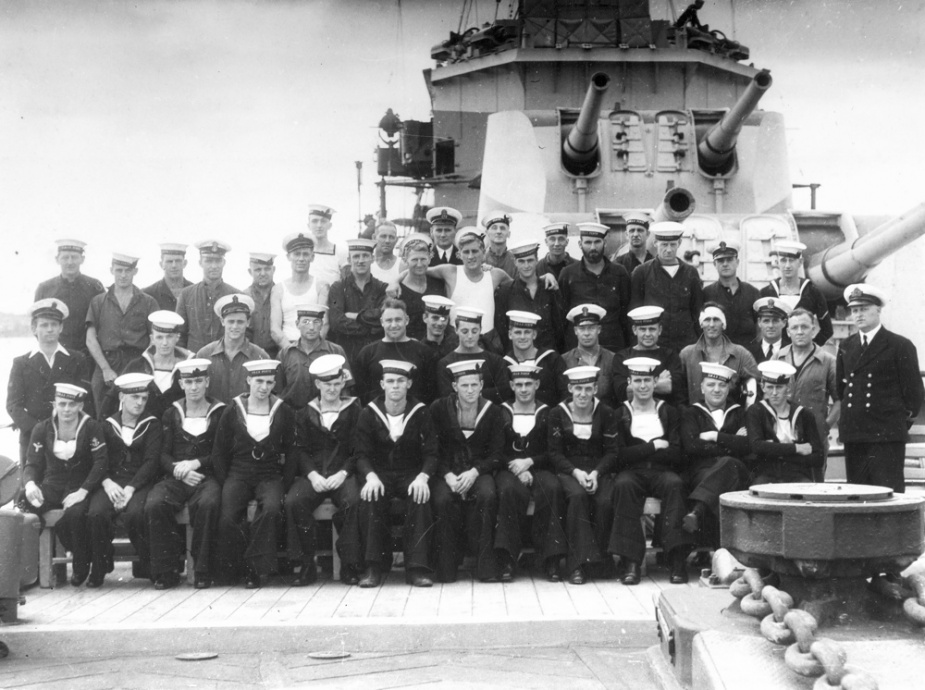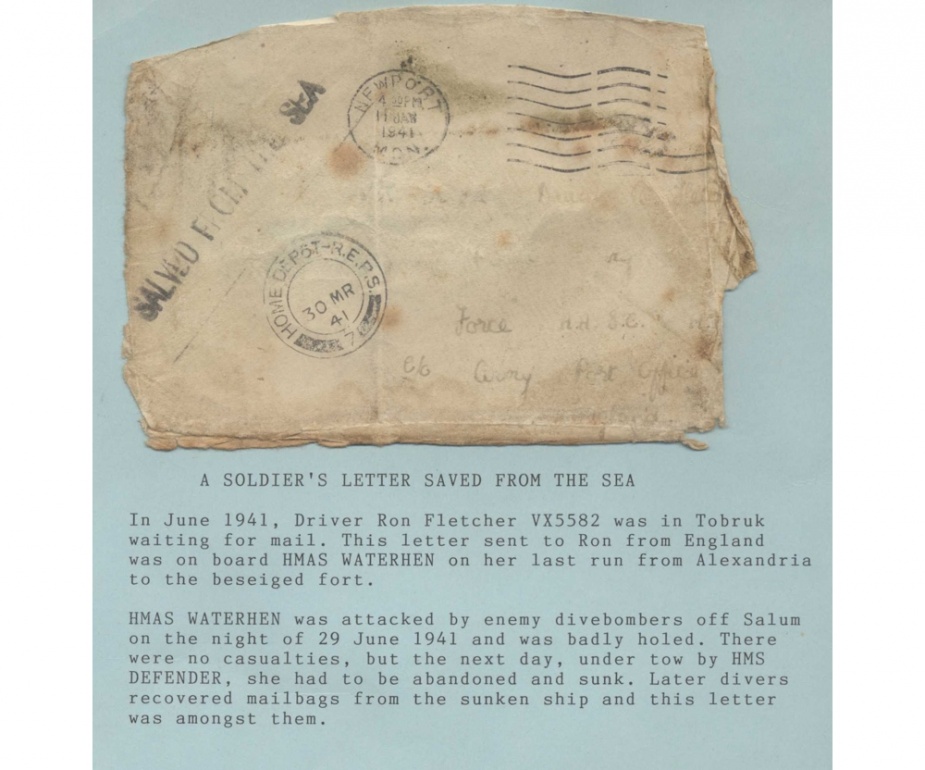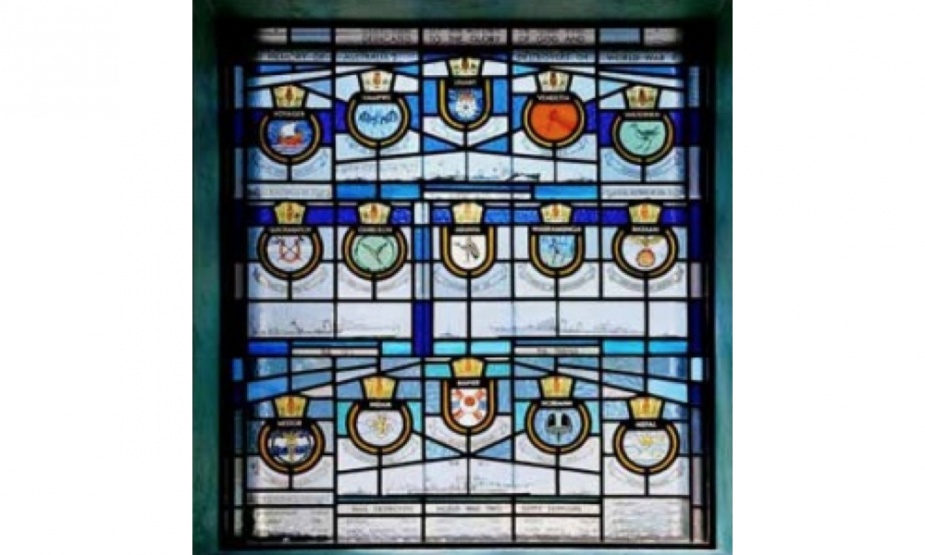HMAS Waterhen (I)
| Class |
V and W Class |
|---|---|
| Type |
Destroyer |
| Pennant |
D22 |
| Builder |
Palmers Shipbuilding Co Lts, Hebburn-on-Tyne, England |
| Laid Down |
3 July 1917 |
| Launched |
23 March 1918 |
| Commissioned |
11 October 1933 |
| Decommissioned |
30 June 1941 |
| Fate |
Lost in action on 30 June 1941 |
| Dimensions & Displacement | |
| Displacement | 1100 tons |
| Length | 312 feet 2 inches |
| Beam | 29 feet 7 inches |
| Draught | 9 feet 8 inches |
| Performance | |
| Speed | 34 knots |
| Complement | |
| Crew | 127 |
| Propulsion | |
| Machinery | Parsons turbines, twin screws |
| Horsepower | 1750 |
| Armament | |
| Guns |
|
| Torpedoes | 6 x 21-inch torpedo tubes (two triple mountings) |
| Awards | |
| Battle Honours | |
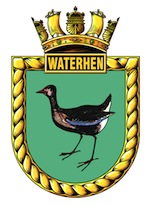
In 1933 the Admiralty agreed to loan the Flotilla Leader Stuart (I) and four V and W Class destroyers (Vampire (I), Vendetta (I), Voyager (I) and Waterhen (I)) to the Royal Australian Navy as replacements for the S Class destroyers (Stalwart, Success, Swordsman, Tasmania and Tattoo) and the Flotilla Leader Anzac, then due for scrapping. Waterhen (I) and the other four ships commissioned in the Royal Australian Navy at Portsmouth on 11 October 1933 to form the Australian Destroyer Flotilla, later to become famous as the 'Scrap Iron Flotilla'.
The Flotilla departed Chatham, under the command of Captain AC Lilley RN (in Stuart (I)), on 17 October 1933 and, proceeding via Suez, reached Singapore on 28 November, Darwin on 7 December and Sydney on 21 December 1933.
Waterhen (I) served on the Australia Station until 9 October 1934 when she paid off at Sydney. She recommissioned on 14 April 1936 and resumed service on the Australia Station. In April 1937 Waterhen (I) visited New Zealand. On 1 June 1938 she again paid off into Reserve at Sydney. The ship remained in Reserve, apart from a short period in commission at the time of the Munich Crisis (29 September 1938 to 10 November 1938) until, with the outbreak of war, she recommissioned on 1 September 1939.
Waterhen (I)'s first wartime duties were anti-submarine patrols based on Sydney, alternating with Stuart (I) and Vendetta (I).
On 14 October 1939, in company with Stuart (I) and Vendetta (I), Waterhen (I) departed Sydney for Singapore, proceeding via Darwin and Lombok Strait. The same day Vampire (I) and Voyager (I) departed Fremantle to join company at Singapore. The Flotilla was under the command of Commander HML Waller RAN (Commander (D)), in Stuart (I).
It had been intended to base the destroyers at Singapore for a period of training but, while the Flotilla was still at sea, it was decided that after a brief stop at Singapore it should proceed to the Mediterranean. The two ships ex Fremantle arrived at Singapore on 21 October 1939 where they were joined on the 29th by Stuart (I), Waterhen (I) and Vendetta (I).
The Flotilla sailed from Singapore on 13 November 1939 but split up en route and consequently the ships did not all reach Malta at the same time. Waterhen (I) arrived on 14 December 1939. From 2 January 1940 the Flotilla formed the 19th Destroyer Division for service with the Mediterranean Fleet.
At this period of the war, British and French naval supremacy in the Mediterranean called for only routine escort and patrol duties, interspersed with Fleet exercises. Nevertheless, the Australian destroyers were kept busy with their routine of escort and patrol work, singly and in pairs, which took them from end to end of the Mediterranean.
On 27 May 1940 the 19th Destroyer Division and the 20th Destroyer Division (HM Ships Dainty, Decoy, Defender and Diamond) combined forces to form the 10th Destroyer Flotilla under the command of Commander Waller.
The entry of Italy into the war on 10 June 1940 and the collapse of French resistance on the 22nd completely changed the naval situation in the Mediterranean. Formerly, all coastlines were either Allied or neutral, and the Anglo-French Fleets were in undisputed command of the seas. Now all coasts except those of Egypt, Palestine and Cyprus in the east, Malta in the centre, and Gibraltar in the west were closed to the Royal Navy. Moreover, the Allies had lost the support of the French Fleet, which had provided seven capital ships and nineteen cruisers, and had acquired a new enemy in Italy with her menacing naval potential. Her fleet boasted five battleships, 25 cruisers, 90 destroyers and nearly one hundred submarines. It spelt the beginning of a long and bitter struggle for control of the Mediterranean, first against the Italian Fleet and Air Force (neither of which proved the menace expected) and later against the much more formidable German Luftwaffe whose dive bombers took grievous toll of British warships before they were finally driven from the skies.
For more than a year the 'Scrap Iron Flotilla' took part in the struggle for possession of the ancient sea route linking east and west. Waterhen (I) was almost constantly at sea, either operating with the fleet or on escort and patrol duties.
On 17 August 1940 Waterhen (I) was one of the destroyers screening the British battleships Warspite, Malaya and Ramillies and the cruiser Kent when they bombarded Italian troop concentrations in Libya at Capuzzo and near Bardia. A week later, in the early hours of the morning of 24 August, Waterhen (I) provided covering fire for the gunboat HMS Ladybird as the latter ship cleared Bardia Harbour under fire from shore batteries after shelling buildings at point blank range.
On 28 October 1940 the Italian Army invaded Greece from Albania and, as part of British plans for the support of Greece, a convoy sailed from Alexandria the following day to establish a fuelling base at Suda Bay, Crete. Waterhen (I) was among the escorting destroyers. By the evening of 1 November 1940 the laying of anti-submarine nets was completed despite enemy air attacks. The following day Waterhen (I) and Vampire (I) sailed for Alexandria escorting the net layer HMS Protector, the armed boarding ships HMS Chakla and HMS Fiona and a fleet oiler. In November 1940 Waterhen (I) acted as escort for several Malta convoys.
As a unit of the Inshore Squadron, Waterhen (I) participated in the Western Desert campaign in North Africa in December 1940. Other RAN members of the Squadron were Vampire (I), Vendetta (I) and Voyager (I). They carried out bombardments and night offensive patrols, protected the supply ships and water carriers and generally maintained the sea supply lines to the shifting battle front.
Three hours after leaving Sollum, Egypt, on Christmas night 1940, Waterhen (I) intercepted an Italian supply vessel Tireremo Diritto and sank her by gunfire after removing twenty-four men and four officers, one Fascist officer and one dog.
Waterhen (I) was forced to withdraw from operations for repairs lasting a month at Port Tewfik, Egypt (at the southern end of the Suez Canal), after colliding with and sinking the anti-submarine trawler HMS Bandolero on 30 December 1940.
On 5 March 1941 Waterhen (I) left the Inshore Squadron to take part in operations in the Aegean. She returned early in April and with Stuart (I), Vendetta (I) and Voyager (I), was engaged in the bombardment of enemy positions in support of the army and in supplying Tobruk.
Waterhen (I) and Vendetta (I) came under attack by dive bombers in Tobruk Harbour on 14 April 1941 but, although the bombs fell close, neither ship was hit. In the evening of the same day, the hospital ships Vita and Devonshire were attacked in the harbour by dive bombers and Vita was damaged by a near miss. While Vendetta (I) circled Vita and Waterhen (I), the latter embarked Vita's patients and staff and early the following morning she sailed for Alexandria.
On 19 April 1941 Waterhen (I), Stuart (I) and Voyager (I) participated as escorts in a commando raid on Bardia by troops carried in the landing ship HMS Glengyle.
During the campaigns in Greece and Crete Waterhen (I) had escorted convoys on several occasions. When the Greek campaign was finally seen to be a lost cause, she played her part in evacuating the Allied troops by embarking seventy men at Megara, Greece, on 26 April 1941 and disembarking them at Suda Bay. The following month she assisted in the evacuation of Crete.
In May 1941 the regular 'Tobruk Ferry Service' for the supply and reinforcement of the beleaguered Australian garrison at Tobruk was instituted by destroyers of the Inshore Squadron. This duty occupied Waterhen (I) for the remainder of her career.
On 28 June 1941 Waterhen (I) left Alexandria for Tobruk with Defender on what was to be her last run. At 7:45pm on 29 June, off Sollum, both ships were attacked by dive bombers and Waterhen (I), though not directly hit, was holed by near misses and immobilized. Her ship's company and embarked troops were taken off by Defender. There were no casualties.
As darkness fell, Defender took Waterhen (I) in tow, but it was soon apparent that she could not be saved and the working party was taken off. At 1:50am on 30 June 1941 the 23-year old 'Chook', as she was affectionately known to her crew, rolled over and sank. She was the first ship of the RAN to be lost by enemy action in World War II.
Further reading
'Scrap Iron Destroyers: The Story of HMA Ships Stuart, Vampire, Vendetta, Voyager and Waterhen' by LJ Lind and A Payne - published by the Naval Historical Society of Australia, Garden Island, 1976.

